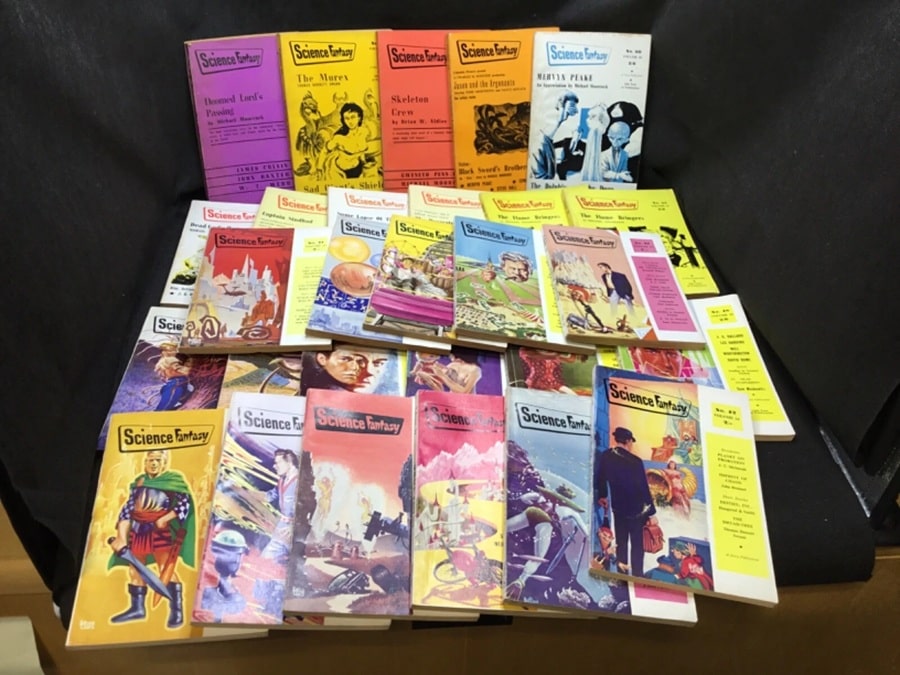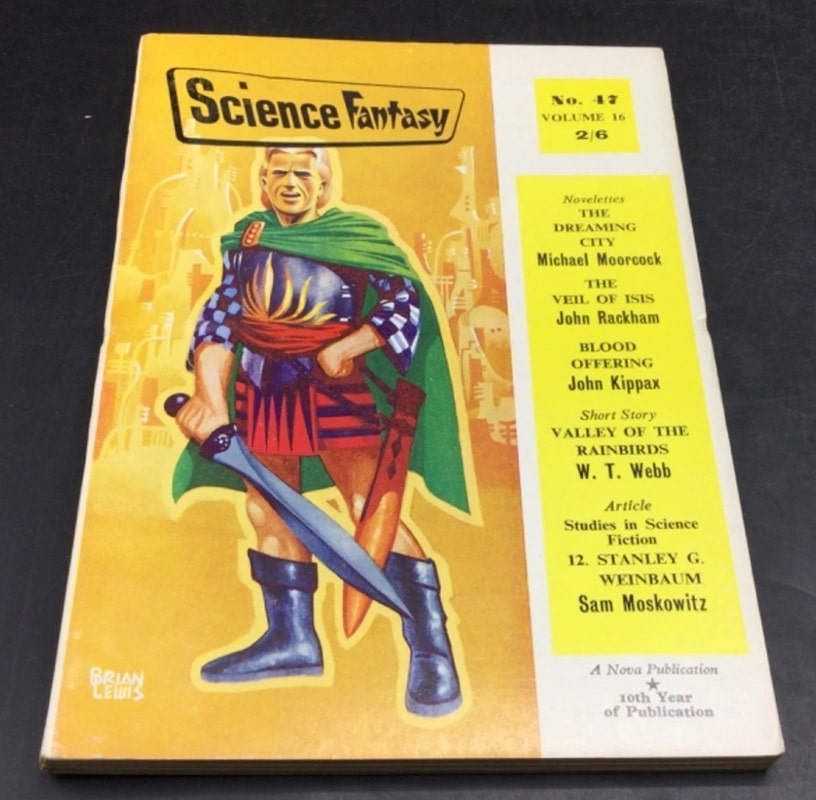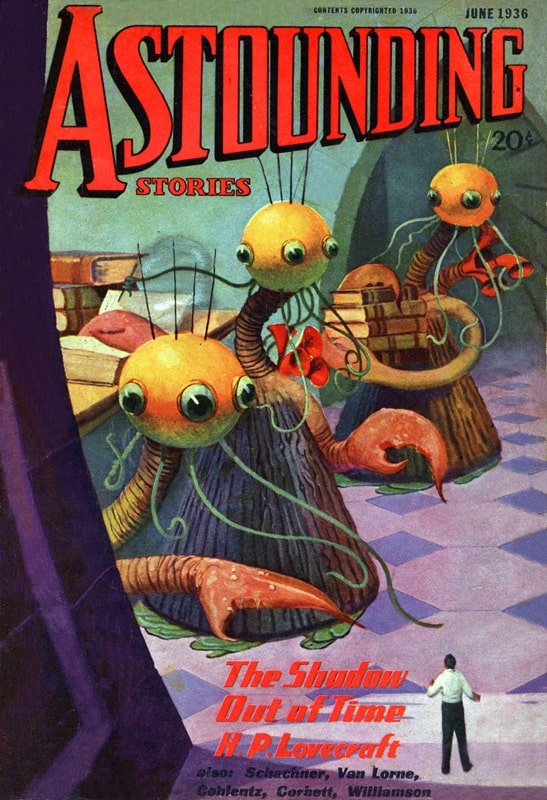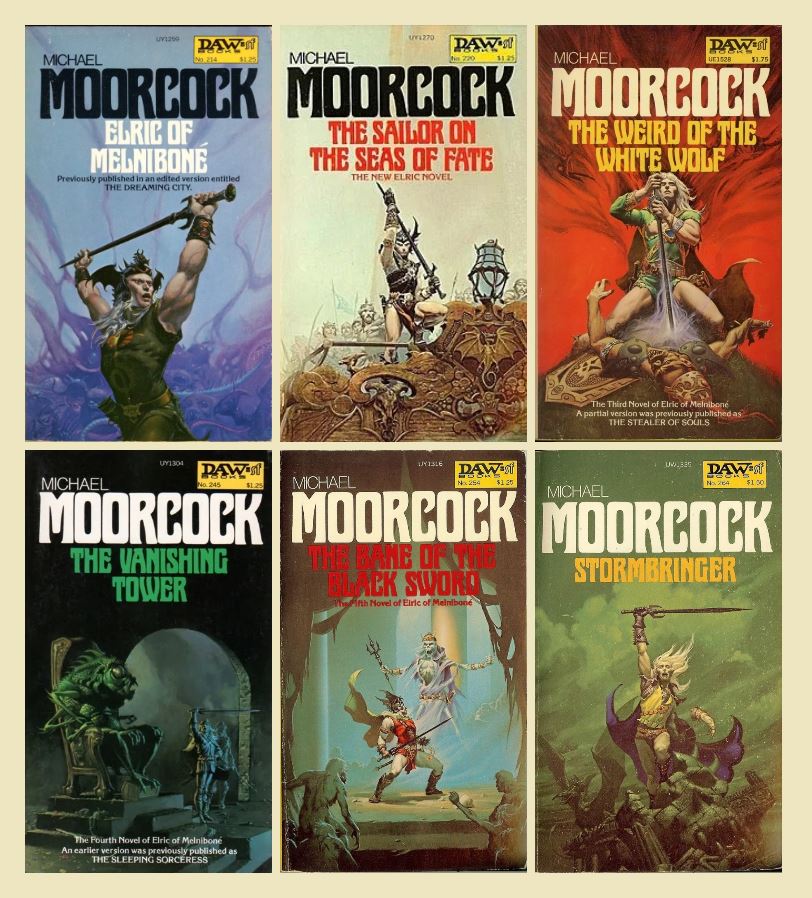Why Did This Lot of Science Fantasy Digests Sell for $1,580? Michael Moorcock, That’s Why

After 25 years of buying vintage digest magazines on eBay, I’m rarely surprised. But I was left with my jaw hanging open last week when a set of 28 Science Fantasy magazines offered on eBay (above) blew past my $98 maximum bid, and ended up selling 9 minutes later for $1,580.
That’s not normal. I bought a set of 39 issues of its sister magazine New Worlds just a few days earlier for $70, not even $2 per issue. Copies of Science Fantasy do tend to command higher prices, but not that much higher. So what’s going on?
It didn’t take long to figure out. Turns out the lot happened to include the June 1961 issue, containing Michael Moorcock’s “The Dreaming City,” the first appearance of Elric of Melniboné.

Here’s the original eBay listing, from seller CollectibleKingdom22.
Now, I’ve seen Science Fantasy 47 listed on eBay at prices of $1000 and up, but you see all kinds of crazy listings on eBay. This is the first time I’ve ever seen a sale in that ballpark.
I’m hardly an expert in British SF digests, so it’s entirely possible that this isn’t surprising for those who follow them closely. It’s also possible that this is an outliner, or a premium price paid for a copy in superb condition (which it is — see above). It’s also possible the presence of other highly collectible issues in the lot made the price worthwhile.
And maybe it’s just a case of two determined bidders going head-to-head in an auction. That’s hardly unusual, especially on eBay.
But it’s also possible that this is not an outlier at all, and we’re witnessing the beginnings of a significant spike in the prices for the early magazine work of Michael Moorcock.
DAW paperback editions of the first six Elric books. Covers by Michael Whelan.
I’ve already seen a very measurable surge in the prices of the early Elric paperbacks, especially those from DAW. Over the past five years or so I’ve seen prices on those rise quicky from a few bucks per copy to $20-30 each in good condition. These days, Moorcock commands more of a premium than Philip K. Dick and Karl Edward Wagner in the paperback marketplace, and that’s saying something.
Of course, paperback prices aren’t the closest yardstick. To really understand why collectors are bidding $1,000 and up for a single magazine, you need to look at pulps — and especially pulps containing the early work of writers like Robert E. Howard and H.P. Lovecraft.
When I started buying pulps on eBay in the late 90s, I was able to pick copies of Astounding Stories with Lovecraft’s famous tales “The Shadows Out of Time” and “At the Mountains of Madness” for $20-30 each (about triple what I paid for other issues from the same era, which I found constantly irritating).
Nowadays those issues sell for ten times that. Shows you what I know.

Of course, what I should have been investing in was Weird Tales, especially issues containing the work of Lovecraft, Clark Ashton Smith, and most especially Robert E. Howard. At the time good condition copies of those issues sold for hundreds, a price I considered ridiculous.
But in the last few years I’ve seen copies of the December 1932 issue of Weird Tales — containing “The Phoenix on the Sword,” the first Conan tale by Robert E. Howard — sell at auction at the Windy City Pulp & Paper show for $12,000 and up.
For the last sixty years, digest magazines have largely avoided the eye-popping runup in prices that occurred with pulps. Unlike pulps, digests have never had the same cachet with collectors, and they’re also easier to store and preserve. Over the last 30 years, as I’ve collected Astounding Science Fiction, Galaxy, World of If, Fantasy & Science Fiction, and dozens of other science fiction and fantasy digests, I’ve usually aimed to pay $1 per issue or less, and that yardstick has allowed me to accumulate a decent collection, including several nearly complete runs. Digest prices have been roughly flat since I started buying them in the 80s.
Are those days coming to an end? It’s too early to tell, of course. But it’s certainly not too early to tell that the work of Michael Moorcock — like Karl Edward Wagner, Philip K. Dick, Robert E. Howard, and others — is rapidly becoming more collectible as more interested buyers enter the market.
Anything that helps bring attention to the most talented writers in our rich history is a positive development. Even if it does mean my collecting budget may have to be revised over the next few years. I’ll try and keep my grumbling to a minimum.
We’ve covered Michael Moorcock’s groundbreaking work on Elric extensively here at Black Gate. Check out some of our recent articles here.

If this is any indication that more people are becoming interested in Michael Moorcock, that can only be a good thing. Fortunately for me I have no desire to acquire these costly collectibles! The UK Grafton editions of the “big six” Elric books (with the same Michael Whelan cover art) crop up relatively often in charity shops here, at very low prices (rarely more than £5 each). I have nearly a full set. The main thing I tend to notice is that they usually have badly faded spines.
Whenever I see something like that–something that sells for such an incredible amount–I instantly suspect money laundering.
Congratulations John. I always love hearing about someone who has been collecting for decades and that particular collectible is now popular. Be it pulps or RPGs or Hot Wheels or record albums. I adhere to the maxim “Collect for enjoyment, not investment. If it becomes valuable, that’s a double bonus.”
Companies like CGC which grade and encapsulate collectibles like comics, records and pulps (and even concert posters) are partially responsible for price jumps: a so-called slabbed collectible sells for several times more than the unslabbed equivalent and people seek out high-grade raw copies in the hope of gaining a 9.8 (9.9 and 10.0 are very hard to get because the item must be flawless). Also, there’s a certain prestige in being able to advertise the item for sale as “highest graded by CGC”.
Interesting article John. Could be so many factors, maybe just a case of that one issue to complete a collection. With old pulps becoming scarce and pricy lay e the collectorsrket is starting to pay more attention to the old digests?
Elric wise as Andy has stated the Grafton and Mayfair books are still readily available at reasonable prices. DAW versions, where I stay, they don’t get seen often.
[…] (Black Gate): After 25 years of buying vintage digest magazines on eBay, I’m rarely surprised. But I was left […]
Very interesting the collectors market is frankly out of my budget though